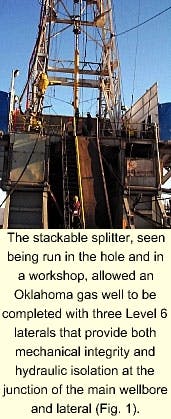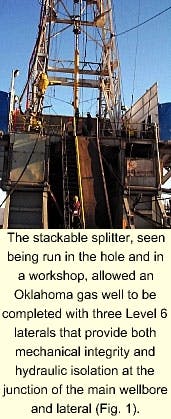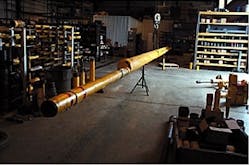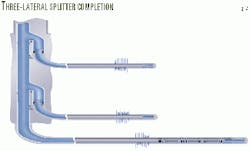Baker Oil Tools says its first-ever commercial application of a stackable splitter, Level 6, three-lateral completion in an Oklahoma gas field provided greater initial production rates than single borehole producers.
The field produces gas from a vertically oriented, multilayered subthrust formation.
Stackable splitters
Baker says its stackable splitter system is one of four Level 6 multilateral systems jointly developed by it and Marathon Oil Co (Fig. 1). The splitter uses the Mara-Split technology, which Marathon licenses to Baker.
Level 6 systems, such as the stackable splitter, provide both mechanical integrity and hydraulic isolation at the junction of the main wellbore and lateral, allowing individual access into each lateral and flow control to zones completed in the main bore or the laterals.
When a well is completed as a commingled producer, a diverter provides access into each lateral, and wireline plugs or cement provide flow control.
With the stackable splitter, up to four laterals can be drilled, cased, and completed from one main wellbore. The Okla homa well had three laterals (Fig. 2).
Baker says its stackable splitter differs from other Level 6 multilateral systems in that the inlet into the junction is the same size as the outlets out of the junction. The stackable splitters are placed and run in the casing string, and a newly design straddle wiper system is used for cementing the string.
Laterals can be drilled and completed with cemented liners in any order, and a diverter is used to for drilling or re-entry into any junction.
Oklahoma trilateral
In the Oklahoma well, Baker says the intent was to set the stackable splitters to allow a 31/2-in. liner to be set in each lateral with a drilling rig.
A diverter, with a selective no-go, would allow selective drilling and re-entry of the laterals, after which the drilling rig would be moved off and replaced with a more cost effective workover rig for perforating and fracture stimulating the well.
Baker describes the well completion as follows:
- After the rig set the 133/8-in. surface casing and drilled the 121/4-in. and 83/4-in. holes to 9,460 ft, it lowered the 51/2-in. casing string with the 51/2 by 51/2 by 51/2 stackable splitters spaced at 7,069 ft measured depth (MD) and 6,575 ft MD.
- The rig ran a selective diverter into the hole after cementing the main bore. It then ran and oriented the diverter and set the diverter in the bottom splitter. After the rig drilled a 43/4-in. hole from the bottom splitter, a 31/2-in. flush joint liner was set at 7,980 ft MD. The liner was cemented and then the rig set a ZXP liner top packer and retrieved the diverter. The diverter was redressed at surface and readied for re-use in the top splitter.
- The procedure was repeated for the top lateral, at 7,624 ft MD. Baker says the selective diverter continued to perform as designed and was retrieved easily with a washover assembly after several passes over the diverter's face with the drilling assembly.
- The well was perforated and stimulated after the laterals were completed. In the lateral, 31/8-in. guns perforated the liner, after which the formation was tested, fractured, and tested again. Next, the selective diverter was set in the bottom splitter, and the bottom lateral was perforated and fractured.
- After the diverter was retrieved and a retrievable plug set above the bottom splitter, the main bore was perforated and fractured between the splitters.
The procedure then was repeated for the top lateral.




